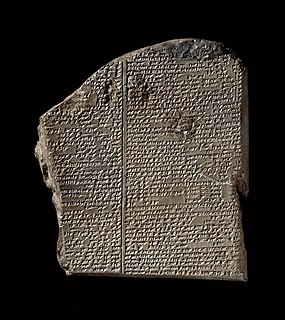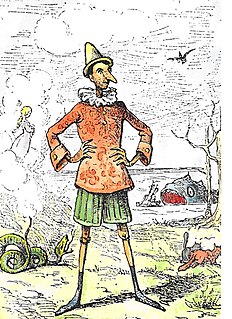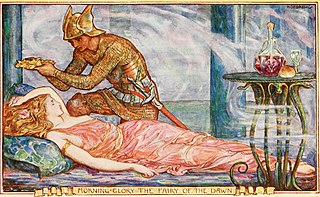Related Research Articles

An epic poem, or simply an epic, is a lengthy narrative poem typically about the extraordinary deeds of extraordinary characters who, in dealings with gods or other superhuman forces, gave shape to the mortal universe for their descendants.

Oral tradition, or oral lore, is a form of human communication wherein knowledge, art, ideas and cultural material is received, preserved, and transmitted orally from one generation to another. The transmission is through speech or song and may include folktales, ballads, chants, prose or verses. In this way, it is possible for a society to transmit oral history, oral literature, oral law and other knowledge across generations without a writing system, or in parallel to a writing system. Religions such as Buddhism, Hinduism, Catholicism, and Jainism, for example, have used an oral tradition, in parallel to a writing system, to transmit their canonical scriptures, rituals, hymns and mythologies from one generation to the next.

Romance films or movies involve romantic love stories recorded in visual media for broadcast in theatres or on television that focus on passion, emotion, and the affectionate romantic involvement of the main characters. Typically their journey through dating, courtship or marriage is featured. These films make the search for romantic love the main plot focus. Occasionally, romance lovers face obstacles such as finances, physical illness, various forms of discrimination, psychological restraints or family resistance. As in all quite strong, deep and close romantic relationships, the tensions of day-to-day life, temptations, and differences in compatibility enter into the plots of romantic films.
Sundiata Keita was a prince and founder of the Mali Empire. The Malian ruler Mansa Musa, known for being the wealthiest person of all time, was his great-nephew.
The folklore of India encompasses the folklore of the nation of India and the Indian subcontinent. India is an ethnically and religiously diverse country. Given this diversity, it is difficult to generalize the vast folklore of India as a unit.
Oral literature or folk literature is a literature that is spoken or sung as opposed to that which is written, though much oral literature has been transcribed. There is no standard definition, as folklorists have varying descriptions for oral literature or folk literature. A broad conceptualization refers to it as literature characterized by oral transmission and the absence of any fixed form. It includes the stories, legends, and history passed from generations in a spoken form.
The Mande Speaking peoples are ethnic groups who are speakers of Mande languages. Various Mandé speaking ethnic groups are found particularly toward the west of West Africa. The Mandé Speaking languages are divided into two primary groups: East Mandé and West Mandé.
Sunjata [] is an epic poem of the Malinke people that tells the story of the hero Sundiata Keita, the founder of the Mali Empire. The epic is an instance of oral tradition, going back to the 13th century and narrated by generations of griot poets or jeliw (djeli). There is no single or authoritative version. Material pertaining to the epic first began to be collected during the early 20th century in French Sudan, notably by the French elite school École William Ponty, resulting in the "modern" version of the tale as considered standard today, as published in "novelistic" form in French translation by Djibril Tamsir Niane in 1960.

Poetry as an oral art form likely predates written text. The earliest poetry is believed to have been recited or sung, employed as a way of remembering oral history, genealogy, and law. Poetry is often closely related to musical traditions, and the earliest poetry exists in the form of hymns, and other types of song such as chants. As such poetry is a verbal art. Many of the poems surviving from the ancient world are recorded prayers, or stories about religious subject matter, but they also include historical accounts, instructions for everyday activities, love songs, and fiction. Many scholars, particularly those researching the Homeric tradition and the oral epics of the Balkans, suggest that early writing shows clear traces of older oral traditions, including the use of repeated phrases as building blocks in larger poetic units. A rhythmic and repetitious form would make a long story easier to remember and retell, before writing was available as a reminder. Thus many ancient works, from the Vedas to the Odyssey, appear to have been composed in poetic form to aid memorization and oral transmission, in prehistoric and ancient societies. Poetry appears among the earliest records of most literate cultures, with poetic fragments found on early monoliths, runestones and stelae.

Nyanga is a township in the Western Cape, South Africa. Its name in Xhosa means "moon" and it is one of the oldest black townships in Cape Town. It was established as a result of the migrant labour system. In 1948 black migrants were forced to settle in Nyanga as Langa had become too small. Nyanga was one of the poorest places in Cape Town and is still is one of the most dangerous parts of Cape Town. In 2001 its unemployment rate was estimated at being approximately 56% and HIV/AIDS is a huge community issue.
Swahili literature is, generally speaking, literature written in the Swahili language, particularly by Swahili people of the East African coast and the neighboring islands. It may also refer to literature written by people who write in the Swahili language. It is an offshoot of the Bantu culture.
The Nyanga language is a language spoken by the Nyanga people in Kivu province, north-eastern Democratic Republic of the Congo. Speaker estimates range from 27,000 to 150,000. Many of the Nyanga speak Congo Swahili, the dominant regional lingua franca, as a second language. Nyanga is a Bantu language. Most of the (scarce) linguistic research conducted on Nyanga has been based on the materials published by Biebuyck and Mateene.

Literature broadly is any collection of written work, but it is also used more narrowly for writings specifically considered to be an art form, especially prose fiction, drama, and poetry. In recent centuries, the definition has expanded to include oral literature, much of which has been transcribed. Literature is a method of recording, preserving, and transmitting knowledge and entertainment, and can also have a social, psychological, spiritual, or political role.

Nyanga District is located in Manicaland Province of Zimbabwe.

Fantasy is a genre of speculative fiction involving magical elements, typically set in a fictional universe and sometimes inspired by mythology and folklore. Its roots are in oral traditions, which then became fantasy literature and drama. From the twentieth century, it has expanded further into various media, including film, television, graphic novels, manga, animations and video games.
Daniel P. Biebuyck was a Belgian scholar of Central African art.

Al-Sirah al-Hilaliyyah, also known as the Sirat Bani Hilal or the al-Hilali epic, is an Arabic epic oral poem that recounts the tale of the journey of the Bedouin tribe of the Banu Hilal from Najd in Arabia to Tunisia and Algeria via Egypt. It is built around historical events that took place in the 11th century. The Banu Hilal were dominant in central North Africa for over a century before their annihilation by the Almohads. The epic is folkloric and oral, not having been committed to writing until relatively recent times, and doesn't have a well-defined date of creation. Of the dozen odd major oral epic poems that developed within the Arab folk tradition between the Middle Ages and the 19th century, Sirat Bani Hilal is today the only one that is still performed in its integral musical form. The longest notable version contains 1,000,000 lines, the poet could sing this version about 100 hours. The epic, once widespread throughout the Middle East, is today performed only in Egypt. In 2008 it was inscribed on UNESCO's Representative List of the Intangible Cultural Heritage of Humanity.
The Nyanga are a Bantu people in the African Great Lakes region. Today they live predominantly in the Kivu region of the Democratic Republic of the Congo, near the frontier with Rwanda and Uganda. They speak the Nyanga language, also called Kinyanga, which is one of the Bantu languages. There are about 150,000 speakers of Nyanga according to a 1994 census, but most are also fluent in Swahili. Their national epic is the karisi Mwindo.
Twitterature is a literary use of the microblogging service of Twitter. It includes various genres, including aphorisms, poetry, and fiction written by individuals or collaboratively. The 280-character maximum imposed by the medium, upgraded from 140 characters in late 2017, provides a creative challenge.

The Black Cloth is a collection of African folk tales by Bernard Binlin Dadié. It was first published in 1955, in French; an English translation by Karen C. Hatch was published in 1987. The stories were published at a time when many African writers were creating a new outlet for traditional African art, converting oral literature into written literature, and adapting writing to convey the tradition of orality.
References
- 1 2 Peek, Philip M.; Yankah, Kwesi, eds. (2004). African Folklore: An Encyclopedia. Routledge. pp. 207–8. ISBN 9781135948726.